NRSG 259 Case Study: Applying Clinical Reasoning to Elderly Care
VerifiedAdded on 2023/06/15
|13
|3364
|379
Case Study
AI Summary
This case study focuses on the care of Mrs. Amalie Jones, an 89-year-old woman with rheumatoid arthritis, osteoarthritis, and macular degeneration. The clinical reasoning cycle is applied to identify care priorities, including restricted mobility, impaired vision, and constipation. Miller’s Functional Consequences Theory is used to develop interventions such as physiotherapy, environmental modifications, and diet management. The case emphasizes the importance of culturally competent care, respecting the patient's German background and maintaining her dignity and autonomy. The goal is to improve her quality of life by addressing her physical and social needs, ensuring she ages gracefully and healthily. The nursing professional must provide fall prevention strategies and promote social interaction to enhance her overall well-being.
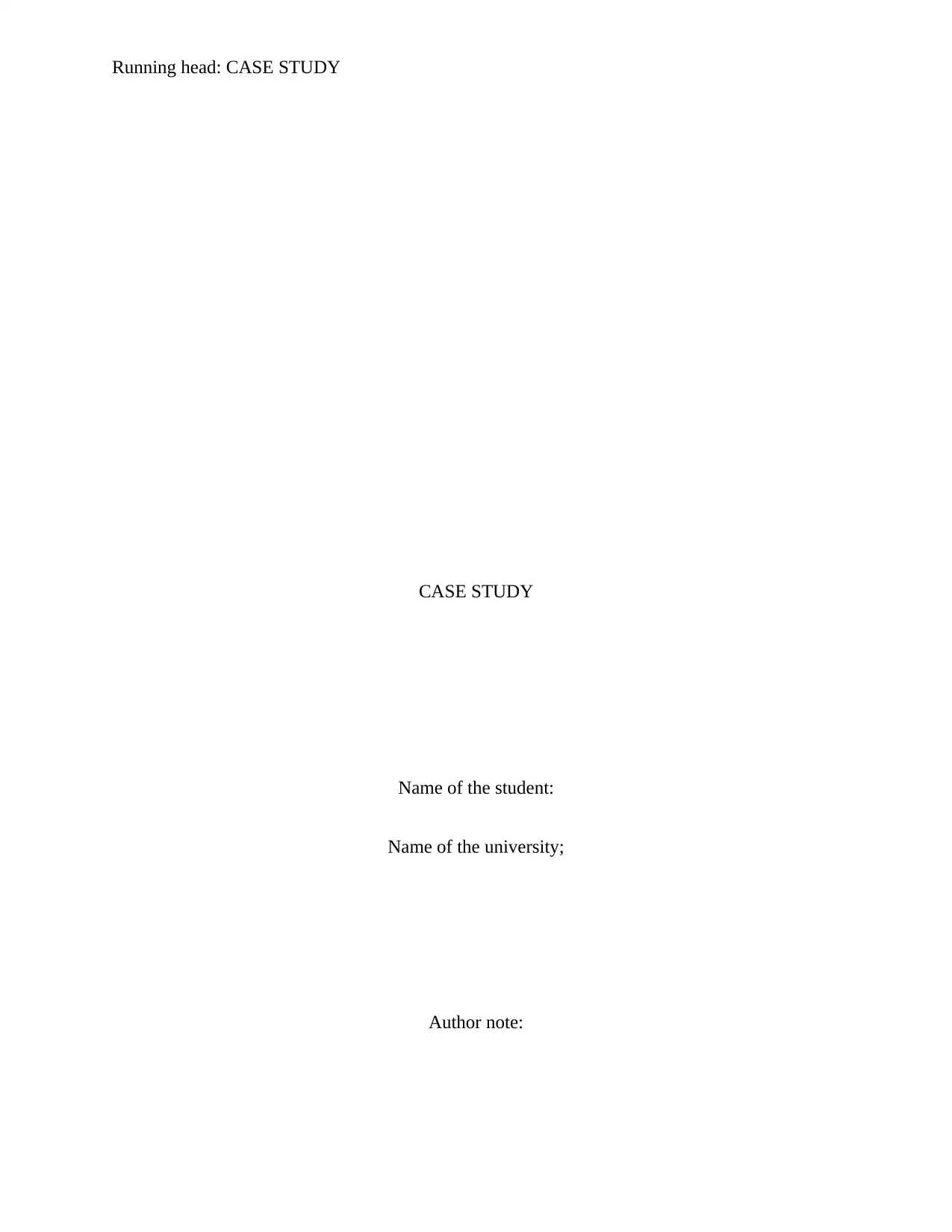
Running head: CASE STUDY
CASE STUDY
Name of the student:
Name of the university;
Author note:
CASE STUDY
Name of the student:
Name of the university;
Author note:
Paraphrase This Document
Need a fresh take? Get an instant paraphrase of this document with our AI Paraphraser
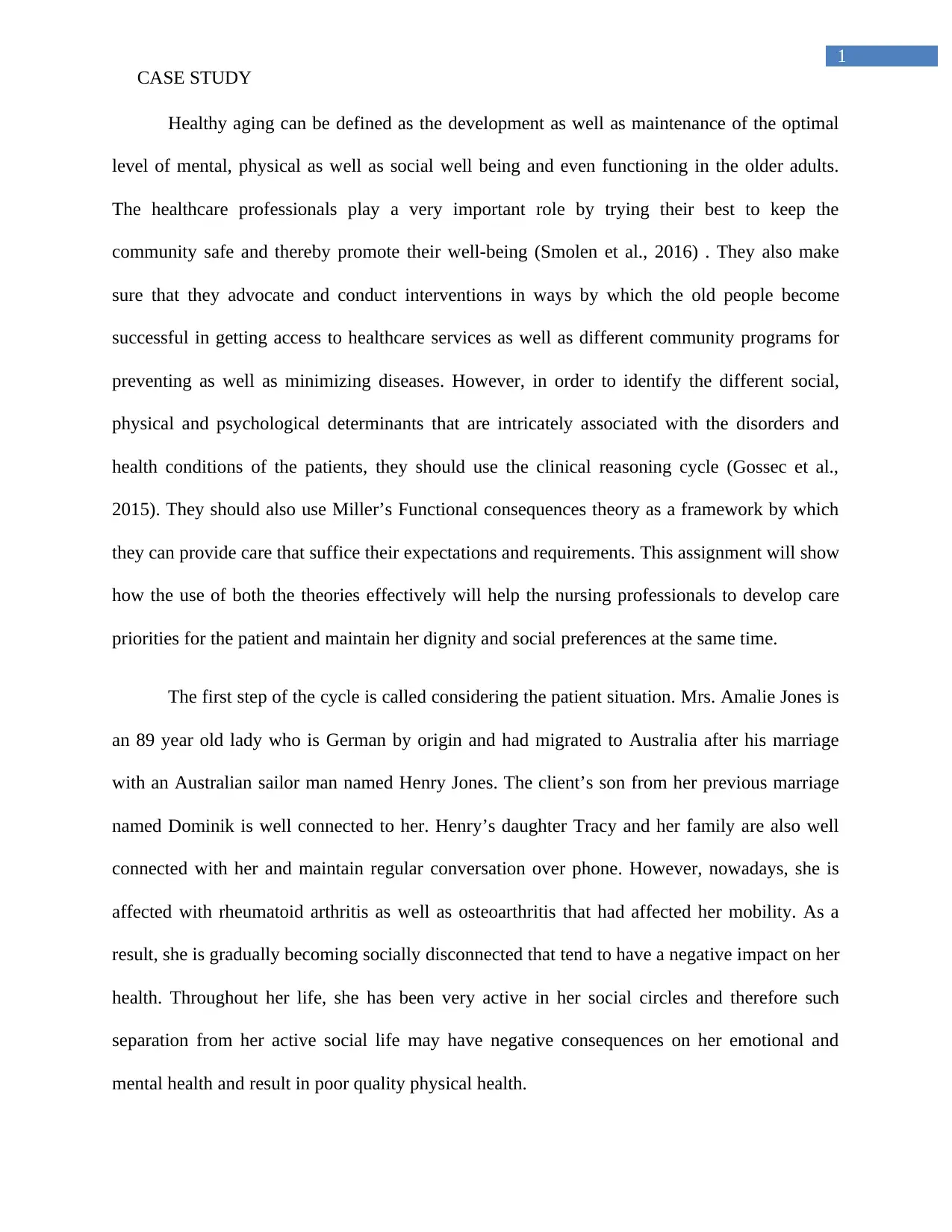
1
CASE STUDY
Healthy aging can be defined as the development as well as maintenance of the optimal
level of mental, physical as well as social well being and even functioning in the older adults.
The healthcare professionals play a very important role by trying their best to keep the
community safe and thereby promote their well-being (Smolen et al., 2016) . They also make
sure that they advocate and conduct interventions in ways by which the old people become
successful in getting access to healthcare services as well as different community programs for
preventing as well as minimizing diseases. However, in order to identify the different social,
physical and psychological determinants that are intricately associated with the disorders and
health conditions of the patients, they should use the clinical reasoning cycle (Gossec et al.,
2015). They should also use Miller’s Functional consequences theory as a framework by which
they can provide care that suffice their expectations and requirements. This assignment will show
how the use of both the theories effectively will help the nursing professionals to develop care
priorities for the patient and maintain her dignity and social preferences at the same time.
The first step of the cycle is called considering the patient situation. Mrs. Amalie Jones is
an 89 year old lady who is German by origin and had migrated to Australia after his marriage
with an Australian sailor man named Henry Jones. The client’s son from her previous marriage
named Dominik is well connected to her. Henry’s daughter Tracy and her family are also well
connected with her and maintain regular conversation over phone. However, nowadays, she is
affected with rheumatoid arthritis as well as osteoarthritis that had affected her mobility. As a
result, she is gradually becoming socially disconnected that tend to have a negative impact on her
health. Throughout her life, she has been very active in her social circles and therefore such
separation from her active social life may have negative consequences on her emotional and
mental health and result in poor quality physical health.
CASE STUDY
Healthy aging can be defined as the development as well as maintenance of the optimal
level of mental, physical as well as social well being and even functioning in the older adults.
The healthcare professionals play a very important role by trying their best to keep the
community safe and thereby promote their well-being (Smolen et al., 2016) . They also make
sure that they advocate and conduct interventions in ways by which the old people become
successful in getting access to healthcare services as well as different community programs for
preventing as well as minimizing diseases. However, in order to identify the different social,
physical and psychological determinants that are intricately associated with the disorders and
health conditions of the patients, they should use the clinical reasoning cycle (Gossec et al.,
2015). They should also use Miller’s Functional consequences theory as a framework by which
they can provide care that suffice their expectations and requirements. This assignment will show
how the use of both the theories effectively will help the nursing professionals to develop care
priorities for the patient and maintain her dignity and social preferences at the same time.
The first step of the cycle is called considering the patient situation. Mrs. Amalie Jones is
an 89 year old lady who is German by origin and had migrated to Australia after his marriage
with an Australian sailor man named Henry Jones. The client’s son from her previous marriage
named Dominik is well connected to her. Henry’s daughter Tracy and her family are also well
connected with her and maintain regular conversation over phone. However, nowadays, she is
affected with rheumatoid arthritis as well as osteoarthritis that had affected her mobility. As a
result, she is gradually becoming socially disconnected that tend to have a negative impact on her
health. Throughout her life, she has been very active in her social circles and therefore such
separation from her active social life may have negative consequences on her emotional and
mental health and result in poor quality physical health.
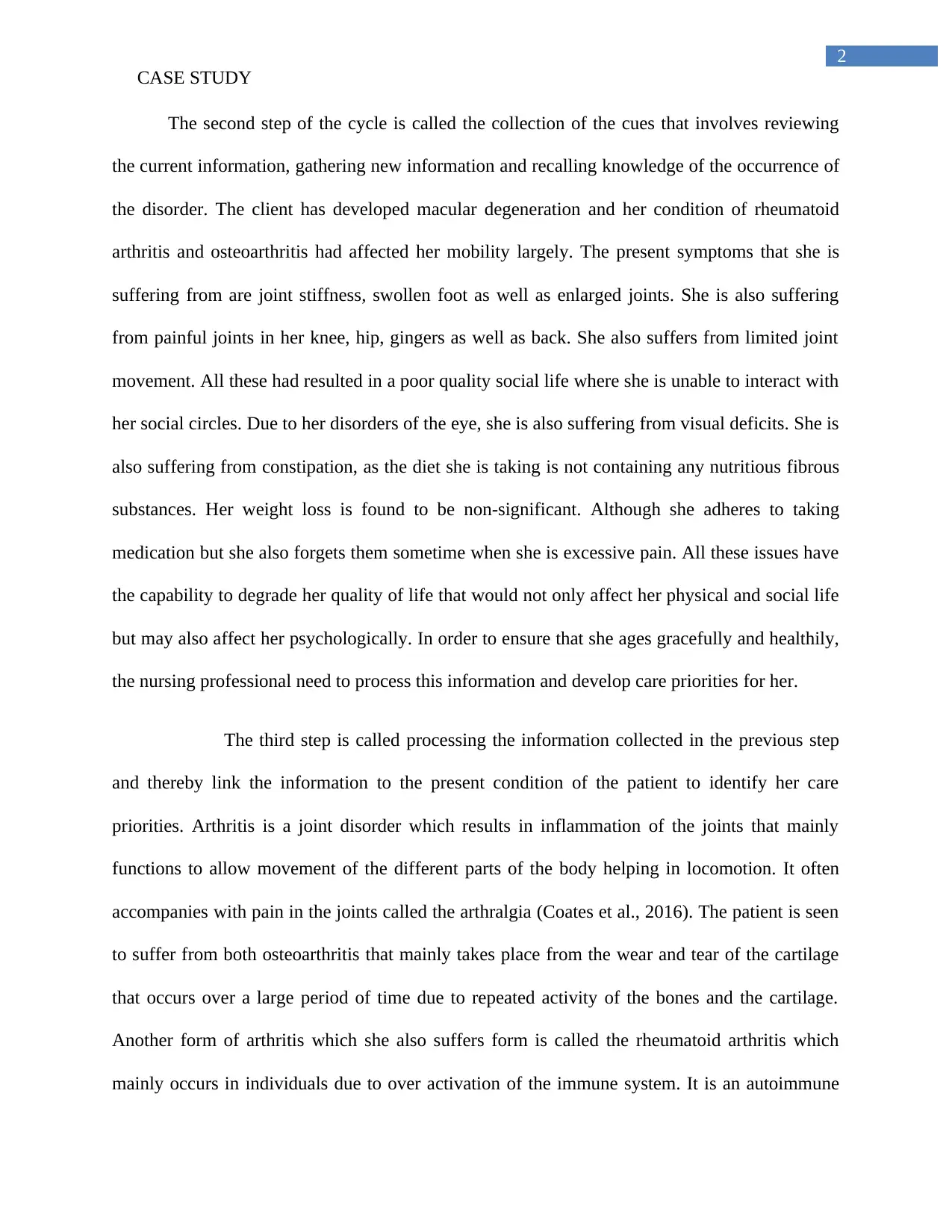
2
CASE STUDY
The second step of the cycle is called the collection of the cues that involves reviewing
the current information, gathering new information and recalling knowledge of the occurrence of
the disorder. The client has developed macular degeneration and her condition of rheumatoid
arthritis and osteoarthritis had affected her mobility largely. The present symptoms that she is
suffering from are joint stiffness, swollen foot as well as enlarged joints. She is also suffering
from painful joints in her knee, hip, gingers as well as back. She also suffers from limited joint
movement. All these had resulted in a poor quality social life where she is unable to interact with
her social circles. Due to her disorders of the eye, she is also suffering from visual deficits. She is
also suffering from constipation, as the diet she is taking is not containing any nutritious fibrous
substances. Her weight loss is found to be non-significant. Although she adheres to taking
medication but she also forgets them sometime when she is excessive pain. All these issues have
the capability to degrade her quality of life that would not only affect her physical and social life
but may also affect her psychologically. In order to ensure that she ages gracefully and healthily,
the nursing professional need to process this information and develop care priorities for her.
The third step is called processing the information collected in the previous step
and thereby link the information to the present condition of the patient to identify her care
priorities. Arthritis is a joint disorder which results in inflammation of the joints that mainly
functions to allow movement of the different parts of the body helping in locomotion. It often
accompanies with pain in the joints called the arthralgia (Coates et al., 2016). The patient is seen
to suffer from both osteoarthritis that mainly takes place from the wear and tear of the cartilage
that occurs over a large period of time due to repeated activity of the bones and the cartilage.
Another form of arthritis which she also suffers form is called the rheumatoid arthritis which
mainly occurs in individuals due to over activation of the immune system. It is an autoimmune
CASE STUDY
The second step of the cycle is called the collection of the cues that involves reviewing
the current information, gathering new information and recalling knowledge of the occurrence of
the disorder. The client has developed macular degeneration and her condition of rheumatoid
arthritis and osteoarthritis had affected her mobility largely. The present symptoms that she is
suffering from are joint stiffness, swollen foot as well as enlarged joints. She is also suffering
from painful joints in her knee, hip, gingers as well as back. She also suffers from limited joint
movement. All these had resulted in a poor quality social life where she is unable to interact with
her social circles. Due to her disorders of the eye, she is also suffering from visual deficits. She is
also suffering from constipation, as the diet she is taking is not containing any nutritious fibrous
substances. Her weight loss is found to be non-significant. Although she adheres to taking
medication but she also forgets them sometime when she is excessive pain. All these issues have
the capability to degrade her quality of life that would not only affect her physical and social life
but may also affect her psychologically. In order to ensure that she ages gracefully and healthily,
the nursing professional need to process this information and develop care priorities for her.
The third step is called processing the information collected in the previous step
and thereby link the information to the present condition of the patient to identify her care
priorities. Arthritis is a joint disorder which results in inflammation of the joints that mainly
functions to allow movement of the different parts of the body helping in locomotion. It often
accompanies with pain in the joints called the arthralgia (Coates et al., 2016). The patient is seen
to suffer from both osteoarthritis that mainly takes place from the wear and tear of the cartilage
that occurs over a large period of time due to repeated activity of the bones and the cartilage.
Another form of arthritis which she also suffers form is called the rheumatoid arthritis which
mainly occurs in individuals due to over activation of the immune system. It is an autoimmune
⊘ This is a preview!⊘
Do you want full access?
Subscribe today to unlock all pages.

Trusted by 1+ million students worldwide
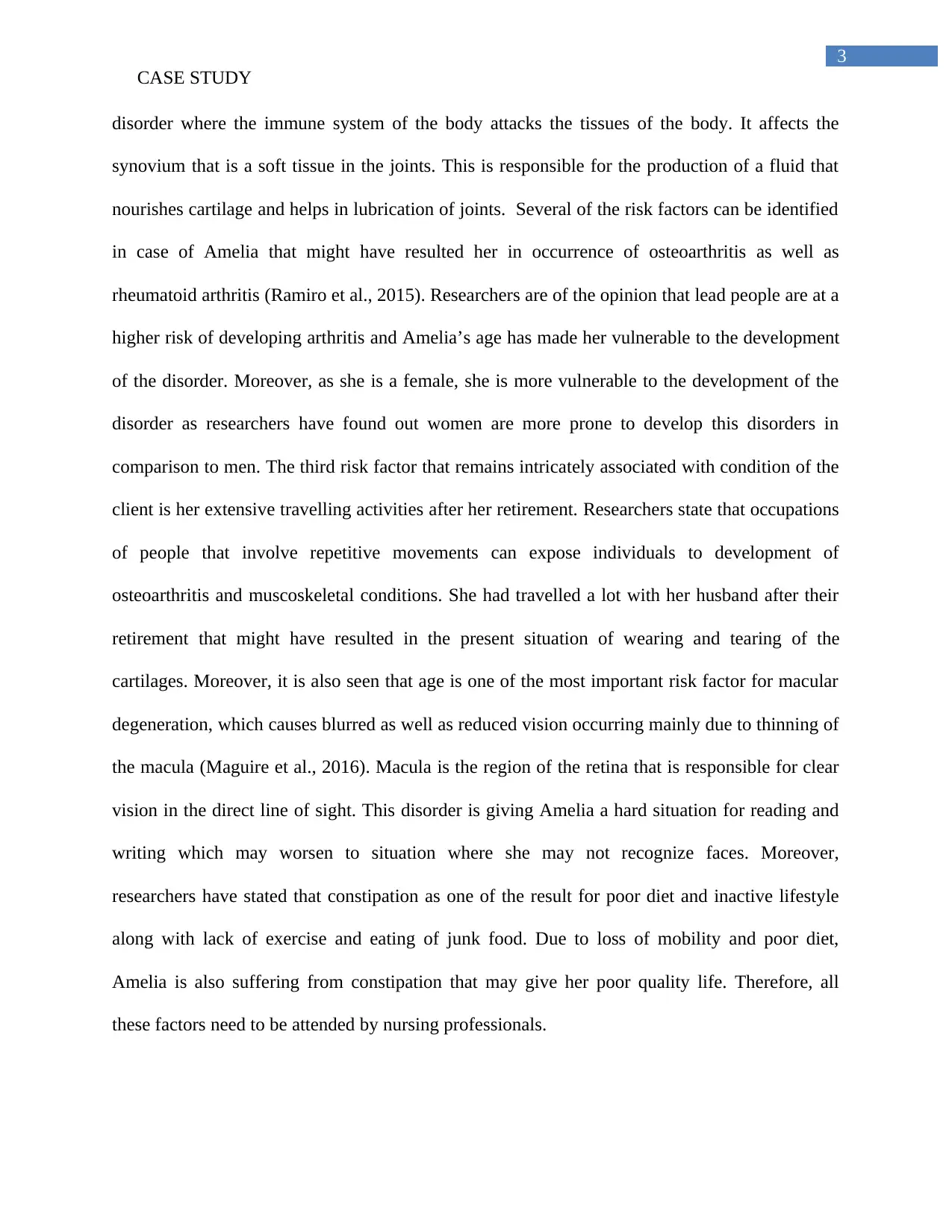
3
CASE STUDY
disorder where the immune system of the body attacks the tissues of the body. It affects the
synovium that is a soft tissue in the joints. This is responsible for the production of a fluid that
nourishes cartilage and helps in lubrication of joints. Several of the risk factors can be identified
in case of Amelia that might have resulted her in occurrence of osteoarthritis as well as
rheumatoid arthritis (Ramiro et al., 2015). Researchers are of the opinion that lead people are at a
higher risk of developing arthritis and Amelia’s age has made her vulnerable to the development
of the disorder. Moreover, as she is a female, she is more vulnerable to the development of the
disorder as researchers have found out women are more prone to develop this disorders in
comparison to men. The third risk factor that remains intricately associated with condition of the
client is her extensive travelling activities after her retirement. Researchers state that occupations
of people that involve repetitive movements can expose individuals to development of
osteoarthritis and muscoskeletal conditions. She had travelled a lot with her husband after their
retirement that might have resulted in the present situation of wearing and tearing of the
cartilages. Moreover, it is also seen that age is one of the most important risk factor for macular
degeneration, which causes blurred as well as reduced vision occurring mainly due to thinning of
the macula (Maguire et al., 2016). Macula is the region of the retina that is responsible for clear
vision in the direct line of sight. This disorder is giving Amelia a hard situation for reading and
writing which may worsen to situation where she may not recognize faces. Moreover,
researchers have stated that constipation as one of the result for poor diet and inactive lifestyle
along with lack of exercise and eating of junk food. Due to loss of mobility and poor diet,
Amelia is also suffering from constipation that may give her poor quality life. Therefore, all
these factors need to be attended by nursing professionals.
CASE STUDY
disorder where the immune system of the body attacks the tissues of the body. It affects the
synovium that is a soft tissue in the joints. This is responsible for the production of a fluid that
nourishes cartilage and helps in lubrication of joints. Several of the risk factors can be identified
in case of Amelia that might have resulted her in occurrence of osteoarthritis as well as
rheumatoid arthritis (Ramiro et al., 2015). Researchers are of the opinion that lead people are at a
higher risk of developing arthritis and Amelia’s age has made her vulnerable to the development
of the disorder. Moreover, as she is a female, she is more vulnerable to the development of the
disorder as researchers have found out women are more prone to develop this disorders in
comparison to men. The third risk factor that remains intricately associated with condition of the
client is her extensive travelling activities after her retirement. Researchers state that occupations
of people that involve repetitive movements can expose individuals to development of
osteoarthritis and muscoskeletal conditions. She had travelled a lot with her husband after their
retirement that might have resulted in the present situation of wearing and tearing of the
cartilages. Moreover, it is also seen that age is one of the most important risk factor for macular
degeneration, which causes blurred as well as reduced vision occurring mainly due to thinning of
the macula (Maguire et al., 2016). Macula is the region of the retina that is responsible for clear
vision in the direct line of sight. This disorder is giving Amelia a hard situation for reading and
writing which may worsen to situation where she may not recognize faces. Moreover,
researchers have stated that constipation as one of the result for poor diet and inactive lifestyle
along with lack of exercise and eating of junk food. Due to loss of mobility and poor diet,
Amelia is also suffering from constipation that may give her poor quality life. Therefore, all
these factors need to be attended by nursing professionals.
Paraphrase This Document
Need a fresh take? Get an instant paraphrase of this document with our AI Paraphraser

4
CASE STUDY
The fourth step is called the identification of the problem and issues. This step thereby
helps in definite diagnosis of the problems of the patients. From the entire discussion, there
important care priorities have been identified by the restricted mobility of the patient due to both
the types of arthritis. Therefore, her mobility needs to be developed (Schwartz et al., 2015). The
second nursing priority is her impaired vision that is mainly due to occurrence of macular
degeneration. Therefore, care should be taken so that she develops better quality life. The third
care priority is her issues with constipation that often affects lives of individuals affecting their
quality life. Therefore, care should be taken so that her issues of constipation can be handled
effectively helping her overcome the symptoms effectively.
The fifth step is called the establishment of the goal stage that mainly involves the
nursing professionals to set goals after analyzing the care priorities of the patient (Levett-Jones,
2013). From the first two care priorities, the most important intervention that needs to be taken
for ensuring safe life of the patient is fall prevention strategies. As she is suffering from loss of
mobility and impaired vision, it becomes very important for the professional to provide fall
prevention strategies. From the third care priority, the nursing professional should involve diet
management strategies as well as develop interventions by which she can engage in interactions
with the society so that they can develop her quality of life and so that she can age gracefully
(Nam et al., 2014).
The fifth step is called the taking action stage. In this stage, the professionals should
introduce interventions for developing the health condition of patients. In this case, the nursing
professionals need to apply another theory while developing care plan for the patient. They
should follow Miller’s theory of functional consequences (Combe et al., 2017). The nurses
should understand that every aged individual have to experience different functional
CASE STUDY
The fourth step is called the identification of the problem and issues. This step thereby
helps in definite diagnosis of the problems of the patients. From the entire discussion, there
important care priorities have been identified by the restricted mobility of the patient due to both
the types of arthritis. Therefore, her mobility needs to be developed (Schwartz et al., 2015). The
second nursing priority is her impaired vision that is mainly due to occurrence of macular
degeneration. Therefore, care should be taken so that she develops better quality life. The third
care priority is her issues with constipation that often affects lives of individuals affecting their
quality life. Therefore, care should be taken so that her issues of constipation can be handled
effectively helping her overcome the symptoms effectively.
The fifth step is called the establishment of the goal stage that mainly involves the
nursing professionals to set goals after analyzing the care priorities of the patient (Levett-Jones,
2013). From the first two care priorities, the most important intervention that needs to be taken
for ensuring safe life of the patient is fall prevention strategies. As she is suffering from loss of
mobility and impaired vision, it becomes very important for the professional to provide fall
prevention strategies. From the third care priority, the nursing professional should involve diet
management strategies as well as develop interventions by which she can engage in interactions
with the society so that they can develop her quality of life and so that she can age gracefully
(Nam et al., 2014).
The fifth step is called the taking action stage. In this stage, the professionals should
introduce interventions for developing the health condition of patients. In this case, the nursing
professionals need to apply another theory while developing care plan for the patient. They
should follow Miller’s theory of functional consequences (Combe et al., 2017). The nurses
should understand that every aged individual have to experience different functional
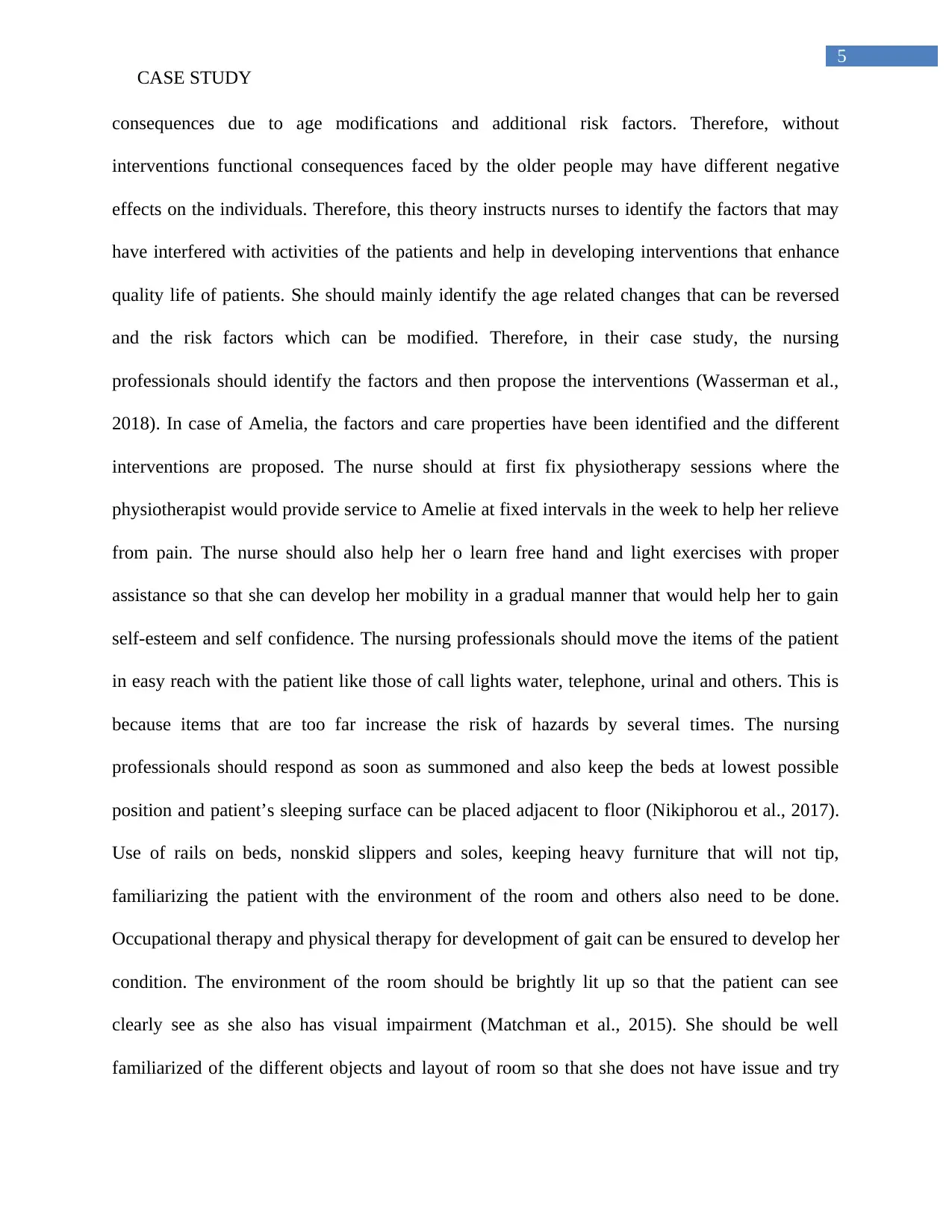
5
CASE STUDY
consequences due to age modifications and additional risk factors. Therefore, without
interventions functional consequences faced by the older people may have different negative
effects on the individuals. Therefore, this theory instructs nurses to identify the factors that may
have interfered with activities of the patients and help in developing interventions that enhance
quality life of patients. She should mainly identify the age related changes that can be reversed
and the risk factors which can be modified. Therefore, in their case study, the nursing
professionals should identify the factors and then propose the interventions (Wasserman et al.,
2018). In case of Amelia, the factors and care properties have been identified and the different
interventions are proposed. The nurse should at first fix physiotherapy sessions where the
physiotherapist would provide service to Amelie at fixed intervals in the week to help her relieve
from pain. The nurse should also help her o learn free hand and light exercises with proper
assistance so that she can develop her mobility in a gradual manner that would help her to gain
self-esteem and self confidence. The nursing professionals should move the items of the patient
in easy reach with the patient like those of call lights water, telephone, urinal and others. This is
because items that are too far increase the risk of hazards by several times. The nursing
professionals should respond as soon as summoned and also keep the beds at lowest possible
position and patient’s sleeping surface can be placed adjacent to floor (Nikiphorou et al., 2017).
Use of rails on beds, nonskid slippers and soles, keeping heavy furniture that will not tip,
familiarizing the patient with the environment of the room and others also need to be done.
Occupational therapy and physical therapy for development of gait can be ensured to develop her
condition. The environment of the room should be brightly lit up so that the patient can see
clearly see as she also has visual impairment (Matchman et al., 2015). She should be well
familiarized of the different objects and layout of room so that she does not have issue and try
CASE STUDY
consequences due to age modifications and additional risk factors. Therefore, without
interventions functional consequences faced by the older people may have different negative
effects on the individuals. Therefore, this theory instructs nurses to identify the factors that may
have interfered with activities of the patients and help in developing interventions that enhance
quality life of patients. She should mainly identify the age related changes that can be reversed
and the risk factors which can be modified. Therefore, in their case study, the nursing
professionals should identify the factors and then propose the interventions (Wasserman et al.,
2018). In case of Amelia, the factors and care properties have been identified and the different
interventions are proposed. The nurse should at first fix physiotherapy sessions where the
physiotherapist would provide service to Amelie at fixed intervals in the week to help her relieve
from pain. The nurse should also help her o learn free hand and light exercises with proper
assistance so that she can develop her mobility in a gradual manner that would help her to gain
self-esteem and self confidence. The nursing professionals should move the items of the patient
in easy reach with the patient like those of call lights water, telephone, urinal and others. This is
because items that are too far increase the risk of hazards by several times. The nursing
professionals should respond as soon as summoned and also keep the beds at lowest possible
position and patient’s sleeping surface can be placed adjacent to floor (Nikiphorou et al., 2017).
Use of rails on beds, nonskid slippers and soles, keeping heavy furniture that will not tip,
familiarizing the patient with the environment of the room and others also need to be done.
Occupational therapy and physical therapy for development of gait can be ensured to develop her
condition. The environment of the room should be brightly lit up so that the patient can see
clearly see as she also has visual impairment (Matchman et al., 2015). She should be well
familiarized of the different objects and layout of room so that she does not have issue and try
⊘ This is a preview!⊘
Do you want full access?
Subscribe today to unlock all pages.

Trusted by 1+ million students worldwide

6
CASE STUDY
hard to visualize any object. A proper diet plan should be given to her and she should be taught
the importance of proper diet in her regular life so that she does not suffer from constipation.
The patient is German by origin and her English is not easily understandable by
others. Therefore, the care that should be devised by the nursing professional should be culturally
and ethically competent. The nursing professionals should develop cultural awareness and should
provide culturally sensitive and culturally competent care to the patients. They should be aware
of the German traditions, preferences and inhibitions and thereby follow such traditions while
providing care to the patients. (Kavanaugh et al., 2014) The nurse should be careful that she does
not ask the patient to repeat as that might affect the self-respect of the patient. In order to
maintain her dignity and autonomy, the nursing professional should make sure that they ask for
her informed consent so that she does not feel disrespected or low in self-esteem as because of
her loss of functions in her old age (Hunter, 2016).
The next step is the evaluation of the outcomes and reflecting on the process. The nursing
professionals should evaluate that the patient is able to move and locomote successfully on a
gradual note. Risk assessment should be done so that she is free from any fall vulnerabilities. Her
condition of constipation has resolved and she is gradually being accommodated with her
condition of the eye that is a symptom of changes due to old age. A therapeutic relationship has
to be developed between the professionals, the patient so that the client can disclose all her
emotions, issues, and concerns and can communicate effectively with the patient (Singh et al.,
2016). The professionals then need to reflect on their practices for enhancing their knowledge
and skills successfully.
CASE STUDY
hard to visualize any object. A proper diet plan should be given to her and she should be taught
the importance of proper diet in her regular life so that she does not suffer from constipation.
The patient is German by origin and her English is not easily understandable by
others. Therefore, the care that should be devised by the nursing professional should be culturally
and ethically competent. The nursing professionals should develop cultural awareness and should
provide culturally sensitive and culturally competent care to the patients. They should be aware
of the German traditions, preferences and inhibitions and thereby follow such traditions while
providing care to the patients. (Kavanaugh et al., 2014) The nurse should be careful that she does
not ask the patient to repeat as that might affect the self-respect of the patient. In order to
maintain her dignity and autonomy, the nursing professional should make sure that they ask for
her informed consent so that she does not feel disrespected or low in self-esteem as because of
her loss of functions in her old age (Hunter, 2016).
The next step is the evaluation of the outcomes and reflecting on the process. The nursing
professionals should evaluate that the patient is able to move and locomote successfully on a
gradual note. Risk assessment should be done so that she is free from any fall vulnerabilities. Her
condition of constipation has resolved and she is gradually being accommodated with her
condition of the eye that is a symptom of changes due to old age. A therapeutic relationship has
to be developed between the professionals, the patient so that the client can disclose all her
emotions, issues, and concerns and can communicate effectively with the patient (Singh et al.,
2016). The professionals then need to reflect on their practices for enhancing their knowledge
and skills successfully.
Paraphrase This Document
Need a fresh take? Get an instant paraphrase of this document with our AI Paraphraser
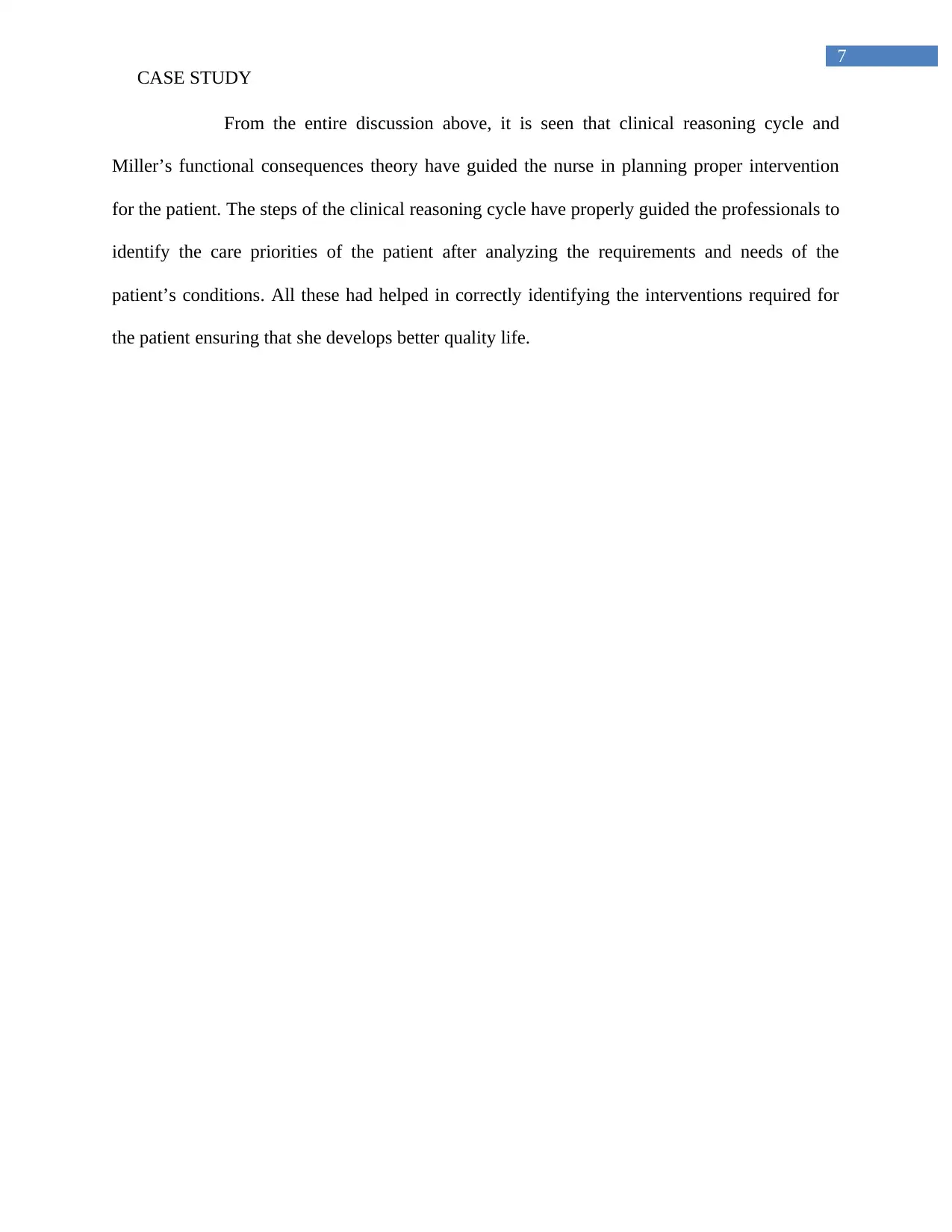
7
CASE STUDY
From the entire discussion above, it is seen that clinical reasoning cycle and
Miller’s functional consequences theory have guided the nurse in planning proper intervention
for the patient. The steps of the clinical reasoning cycle have properly guided the professionals to
identify the care priorities of the patient after analyzing the requirements and needs of the
patient’s conditions. All these had helped in correctly identifying the interventions required for
the patient ensuring that she develops better quality life.
CASE STUDY
From the entire discussion above, it is seen that clinical reasoning cycle and
Miller’s functional consequences theory have guided the nurse in planning proper intervention
for the patient. The steps of the clinical reasoning cycle have properly guided the professionals to
identify the care priorities of the patient after analyzing the requirements and needs of the
patient’s conditions. All these had helped in correctly identifying the interventions required for
the patient ensuring that she develops better quality life.

8
CASE STUDY
References:
Coates, L. C., Kavanaugh, A., Mease, P. J., Soriano, E. R., Laura Acosta‐Felquer, M.,
Armstrong, A. W., ... & Espinoza, L. R. (2016). Group for research and assessment of
psoriasis and psoriatic arthritis 2015 treatment recommendations for psoriatic
arthritis. Arthritis & rheumatology, Vol 68(5), pp 1060-1071.
http://dx.doi.org/10.1136/annrheumdis-2013-204575
Combe, B., Landewe, R., Daien, C. I., Hua, C., Aletaha, D., Álvaro-Gracia, J. M., ... & Conway,
R. (2017). 2016 update of the EULAR recommendations for the management of early
arthritis. Annals of the rheumatic diseases, annrheumdis-2016.
http://dx.doi.org/10.1136/annrheumdis-2016-210602
Gossec, L., Smolen, J. S., Ramiro, S., De Wit, M., Cutolo, M., Dougados, M., ... & Betteridge,
N. (2015). European League Against Rheumatism (EULAR) recommendations for the
management of psoriatic arthritis with pharmacological therapies: 2015 update. Annals of
the rheumatic diseases, annrheumdis-2015. http://dx.doi.org/10.1136/annrheumdis-2015-
208337
Hunter, S. (Ed). (2016). Miller’s nursing for wellness in older adults (2 nd Australia and New
Zealand ed.) North Ryde, NSW: Lippincott, Williams and Wilkins.
Kavanaugh, A., Mease, P. J., Gomez-Reino, J. J., Adebajo, A. O., Wollenhaupt, J., Gladman, D.
D., ... & Hough, D. (2014). Treatment of psoriatic arthritis in a phase 3 randomised,
placebo-controlled trial with apremilast, an oral phosphodiesterase 4 inhibitor. Annals of
CASE STUDY
References:
Coates, L. C., Kavanaugh, A., Mease, P. J., Soriano, E. R., Laura Acosta‐Felquer, M.,
Armstrong, A. W., ... & Espinoza, L. R. (2016). Group for research and assessment of
psoriasis and psoriatic arthritis 2015 treatment recommendations for psoriatic
arthritis. Arthritis & rheumatology, Vol 68(5), pp 1060-1071.
http://dx.doi.org/10.1136/annrheumdis-2013-204575
Combe, B., Landewe, R., Daien, C. I., Hua, C., Aletaha, D., Álvaro-Gracia, J. M., ... & Conway,
R. (2017). 2016 update of the EULAR recommendations for the management of early
arthritis. Annals of the rheumatic diseases, annrheumdis-2016.
http://dx.doi.org/10.1136/annrheumdis-2016-210602
Gossec, L., Smolen, J. S., Ramiro, S., De Wit, M., Cutolo, M., Dougados, M., ... & Betteridge,
N. (2015). European League Against Rheumatism (EULAR) recommendations for the
management of psoriatic arthritis with pharmacological therapies: 2015 update. Annals of
the rheumatic diseases, annrheumdis-2015. http://dx.doi.org/10.1136/annrheumdis-2015-
208337
Hunter, S. (Ed). (2016). Miller’s nursing for wellness in older adults (2 nd Australia and New
Zealand ed.) North Ryde, NSW: Lippincott, Williams and Wilkins.
Kavanaugh, A., Mease, P. J., Gomez-Reino, J. J., Adebajo, A. O., Wollenhaupt, J., Gladman, D.
D., ... & Hough, D. (2014). Treatment of psoriatic arthritis in a phase 3 randomised,
placebo-controlled trial with apremilast, an oral phosphodiesterase 4 inhibitor. Annals of
⊘ This is a preview!⊘
Do you want full access?
Subscribe today to unlock all pages.

Trusted by 1+ million students worldwide
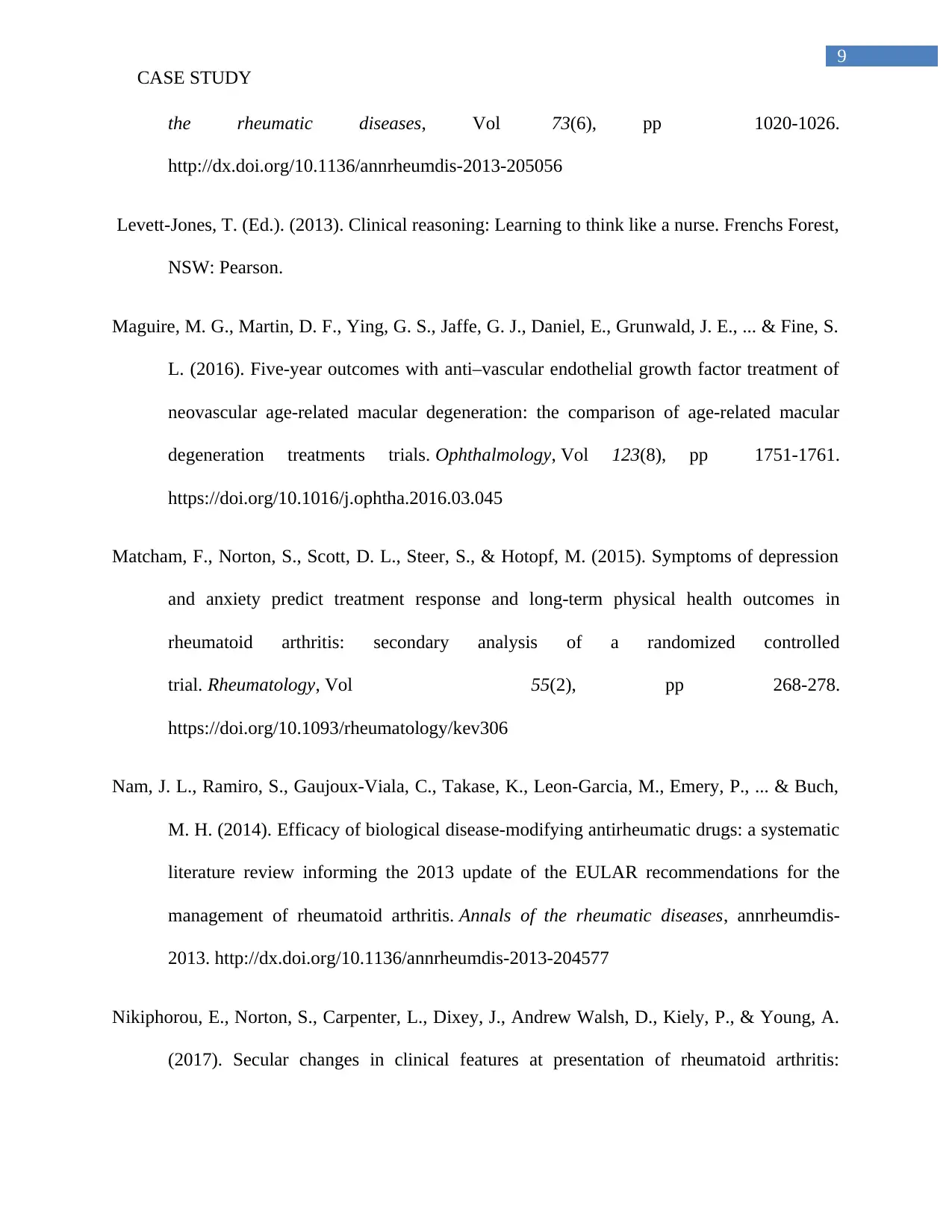
9
CASE STUDY
the rheumatic diseases, Vol 73(6), pp 1020-1026.
http://dx.doi.org/10.1136/annrheumdis-2013-205056
Levett-Jones, T. (Ed.). (2013). Clinical reasoning: Learning to think like a nurse. Frenchs Forest,
NSW: Pearson.
Maguire, M. G., Martin, D. F., Ying, G. S., Jaffe, G. J., Daniel, E., Grunwald, J. E., ... & Fine, S.
L. (2016). Five-year outcomes with anti–vascular endothelial growth factor treatment of
neovascular age-related macular degeneration: the comparison of age-related macular
degeneration treatments trials. Ophthalmology, Vol 123(8), pp 1751-1761.
https://doi.org/10.1016/j.ophtha.2016.03.045
Matcham, F., Norton, S., Scott, D. L., Steer, S., & Hotopf, M. (2015). Symptoms of depression
and anxiety predict treatment response and long-term physical health outcomes in
rheumatoid arthritis: secondary analysis of a randomized controlled
trial. Rheumatology, Vol 55(2), pp 268-278.
https://doi.org/10.1093/rheumatology/kev306
Nam, J. L., Ramiro, S., Gaujoux-Viala, C., Takase, K., Leon-Garcia, M., Emery, P., ... & Buch,
M. H. (2014). Efficacy of biological disease-modifying antirheumatic drugs: a systematic
literature review informing the 2013 update of the EULAR recommendations for the
management of rheumatoid arthritis. Annals of the rheumatic diseases, annrheumdis-
2013. http://dx.doi.org/10.1136/annrheumdis-2013-204577
Nikiphorou, E., Norton, S., Carpenter, L., Dixey, J., Andrew Walsh, D., Kiely, P., & Young, A.
(2017). Secular changes in clinical features at presentation of rheumatoid arthritis:
CASE STUDY
the rheumatic diseases, Vol 73(6), pp 1020-1026.
http://dx.doi.org/10.1136/annrheumdis-2013-205056
Levett-Jones, T. (Ed.). (2013). Clinical reasoning: Learning to think like a nurse. Frenchs Forest,
NSW: Pearson.
Maguire, M. G., Martin, D. F., Ying, G. S., Jaffe, G. J., Daniel, E., Grunwald, J. E., ... & Fine, S.
L. (2016). Five-year outcomes with anti–vascular endothelial growth factor treatment of
neovascular age-related macular degeneration: the comparison of age-related macular
degeneration treatments trials. Ophthalmology, Vol 123(8), pp 1751-1761.
https://doi.org/10.1016/j.ophtha.2016.03.045
Matcham, F., Norton, S., Scott, D. L., Steer, S., & Hotopf, M. (2015). Symptoms of depression
and anxiety predict treatment response and long-term physical health outcomes in
rheumatoid arthritis: secondary analysis of a randomized controlled
trial. Rheumatology, Vol 55(2), pp 268-278.
https://doi.org/10.1093/rheumatology/kev306
Nam, J. L., Ramiro, S., Gaujoux-Viala, C., Takase, K., Leon-Garcia, M., Emery, P., ... & Buch,
M. H. (2014). Efficacy of biological disease-modifying antirheumatic drugs: a systematic
literature review informing the 2013 update of the EULAR recommendations for the
management of rheumatoid arthritis. Annals of the rheumatic diseases, annrheumdis-
2013. http://dx.doi.org/10.1136/annrheumdis-2013-204577
Nikiphorou, E., Norton, S., Carpenter, L., Dixey, J., Andrew Walsh, D., Kiely, P., & Young, A.
(2017). Secular changes in clinical features at presentation of rheumatoid arthritis:
Paraphrase This Document
Need a fresh take? Get an instant paraphrase of this document with our AI Paraphraser
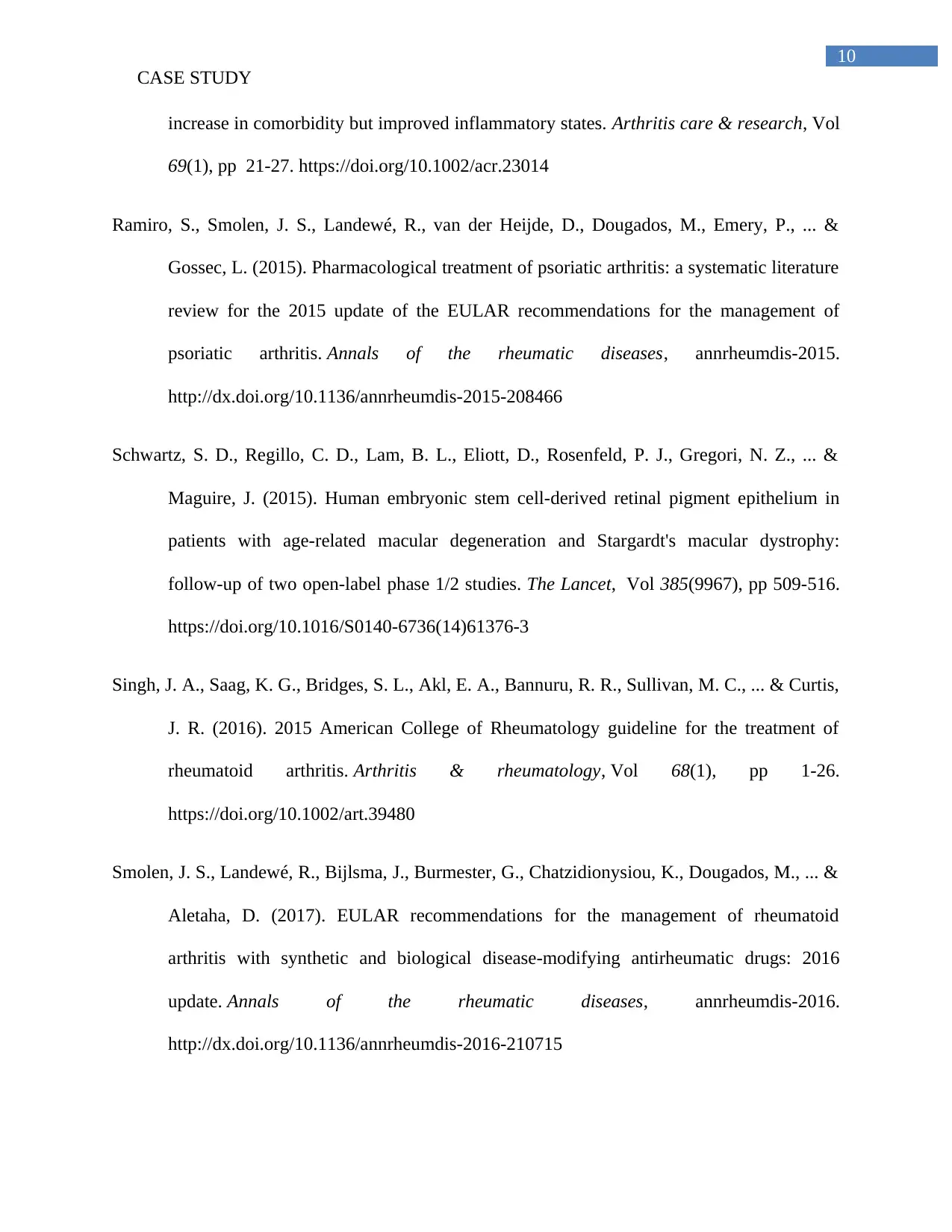
10
CASE STUDY
increase in comorbidity but improved inflammatory states. Arthritis care & research, Vol
69(1), pp 21-27. https://doi.org/10.1002/acr.23014
Ramiro, S., Smolen, J. S., Landewé, R., van der Heijde, D., Dougados, M., Emery, P., ... &
Gossec, L. (2015). Pharmacological treatment of psoriatic arthritis: a systematic literature
review for the 2015 update of the EULAR recommendations for the management of
psoriatic arthritis. Annals of the rheumatic diseases, annrheumdis-2015.
http://dx.doi.org/10.1136/annrheumdis-2015-208466
Schwartz, S. D., Regillo, C. D., Lam, B. L., Eliott, D., Rosenfeld, P. J., Gregori, N. Z., ... &
Maguire, J. (2015). Human embryonic stem cell-derived retinal pigment epithelium in
patients with age-related macular degeneration and Stargardt's macular dystrophy:
follow-up of two open-label phase 1/2 studies. The Lancet, Vol 385(9967), pp 509-516.
https://doi.org/10.1016/S0140-6736(14)61376-3
Singh, J. A., Saag, K. G., Bridges, S. L., Akl, E. A., Bannuru, R. R., Sullivan, M. C., ... & Curtis,
J. R. (2016). 2015 American College of Rheumatology guideline for the treatment of
rheumatoid arthritis. Arthritis & rheumatology, Vol 68(1), pp 1-26.
https://doi.org/10.1002/art.39480
Smolen, J. S., Landewé, R., Bijlsma, J., Burmester, G., Chatzidionysiou, K., Dougados, M., ... &
Aletaha, D. (2017). EULAR recommendations for the management of rheumatoid
arthritis with synthetic and biological disease-modifying antirheumatic drugs: 2016
update. Annals of the rheumatic diseases, annrheumdis-2016.
http://dx.doi.org/10.1136/annrheumdis-2016-210715
CASE STUDY
increase in comorbidity but improved inflammatory states. Arthritis care & research, Vol
69(1), pp 21-27. https://doi.org/10.1002/acr.23014
Ramiro, S., Smolen, J. S., Landewé, R., van der Heijde, D., Dougados, M., Emery, P., ... &
Gossec, L. (2015). Pharmacological treatment of psoriatic arthritis: a systematic literature
review for the 2015 update of the EULAR recommendations for the management of
psoriatic arthritis. Annals of the rheumatic diseases, annrheumdis-2015.
http://dx.doi.org/10.1136/annrheumdis-2015-208466
Schwartz, S. D., Regillo, C. D., Lam, B. L., Eliott, D., Rosenfeld, P. J., Gregori, N. Z., ... &
Maguire, J. (2015). Human embryonic stem cell-derived retinal pigment epithelium in
patients with age-related macular degeneration and Stargardt's macular dystrophy:
follow-up of two open-label phase 1/2 studies. The Lancet, Vol 385(9967), pp 509-516.
https://doi.org/10.1016/S0140-6736(14)61376-3
Singh, J. A., Saag, K. G., Bridges, S. L., Akl, E. A., Bannuru, R. R., Sullivan, M. C., ... & Curtis,
J. R. (2016). 2015 American College of Rheumatology guideline for the treatment of
rheumatoid arthritis. Arthritis & rheumatology, Vol 68(1), pp 1-26.
https://doi.org/10.1002/art.39480
Smolen, J. S., Landewé, R., Bijlsma, J., Burmester, G., Chatzidionysiou, K., Dougados, M., ... &
Aletaha, D. (2017). EULAR recommendations for the management of rheumatoid
arthritis with synthetic and biological disease-modifying antirheumatic drugs: 2016
update. Annals of the rheumatic diseases, annrheumdis-2016.
http://dx.doi.org/10.1136/annrheumdis-2016-210715
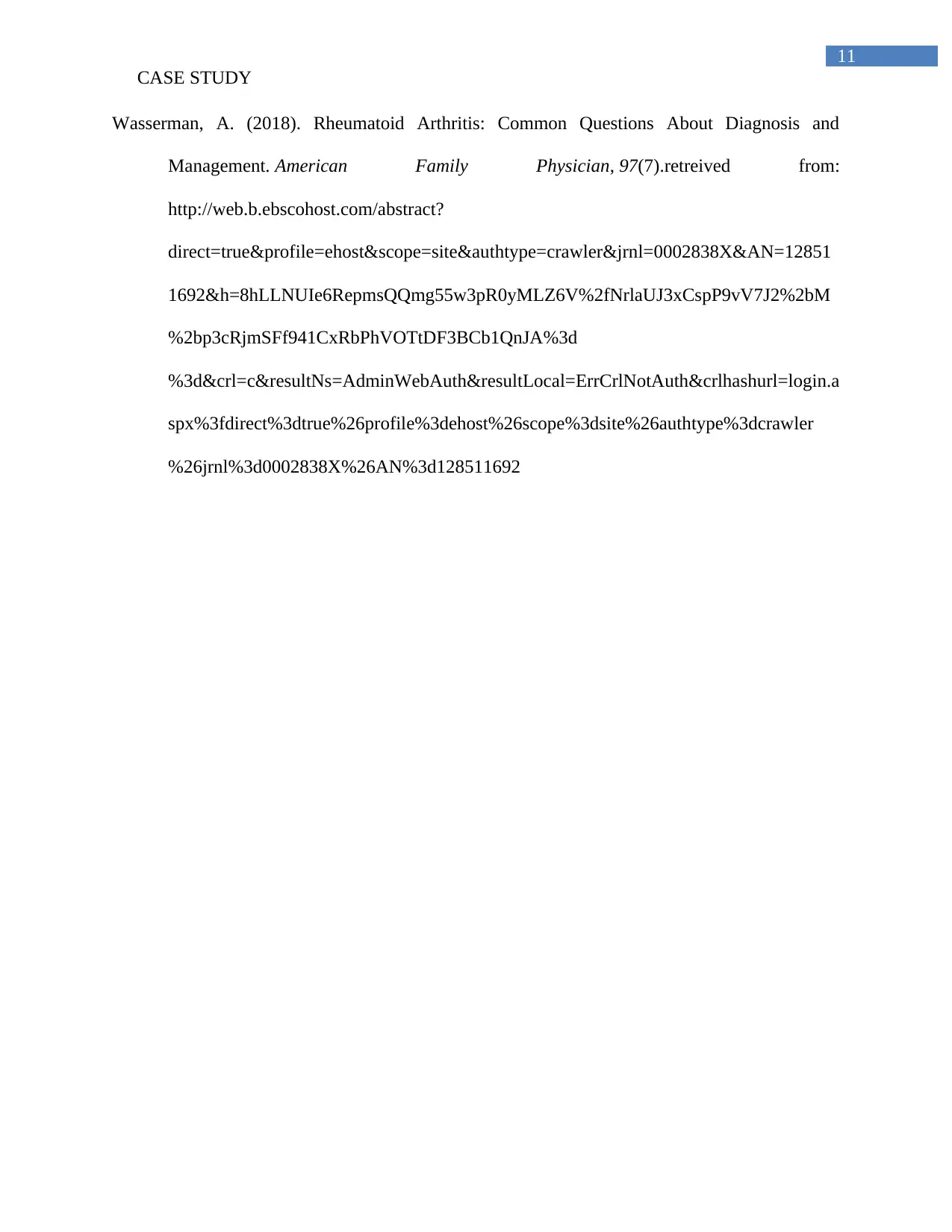
11
CASE STUDY
Wasserman, A. (2018). Rheumatoid Arthritis: Common Questions About Diagnosis and
Management. American Family Physician, 97(7).retreived from:
http://web.b.ebscohost.com/abstract?
direct=true&profile=ehost&scope=site&authtype=crawler&jrnl=0002838X&AN=12851
1692&h=8hLLNUIe6RepmsQQmg55w3pR0yMLZ6V%2fNrlaUJ3xCspP9vV7J2%2bM
%2bp3cRjmSFf941CxRbPhVOTtDF3BCb1QnJA%3d
%3d&crl=c&resultNs=AdminWebAuth&resultLocal=ErrCrlNotAuth&crlhashurl=login.a
spx%3fdirect%3dtrue%26profile%3dehost%26scope%3dsite%26authtype%3dcrawler
%26jrnl%3d0002838X%26AN%3d128511692
CASE STUDY
Wasserman, A. (2018). Rheumatoid Arthritis: Common Questions About Diagnosis and
Management. American Family Physician, 97(7).retreived from:
http://web.b.ebscohost.com/abstract?
direct=true&profile=ehost&scope=site&authtype=crawler&jrnl=0002838X&AN=12851
1692&h=8hLLNUIe6RepmsQQmg55w3pR0yMLZ6V%2fNrlaUJ3xCspP9vV7J2%2bM
%2bp3cRjmSFf941CxRbPhVOTtDF3BCb1QnJA%3d
%3d&crl=c&resultNs=AdminWebAuth&resultLocal=ErrCrlNotAuth&crlhashurl=login.a
spx%3fdirect%3dtrue%26profile%3dehost%26scope%3dsite%26authtype%3dcrawler
%26jrnl%3d0002838X%26AN%3d128511692
⊘ This is a preview!⊘
Do you want full access?
Subscribe today to unlock all pages.

Trusted by 1+ million students worldwide
1 out of 13
Related Documents
Your All-in-One AI-Powered Toolkit for Academic Success.
+13062052269
info@desklib.com
Available 24*7 on WhatsApp / Email
![[object Object]](/_next/static/media/star-bottom.7253800d.svg)
Unlock your academic potential
Copyright © 2020–2025 A2Z Services. All Rights Reserved. Developed and managed by ZUCOL.



